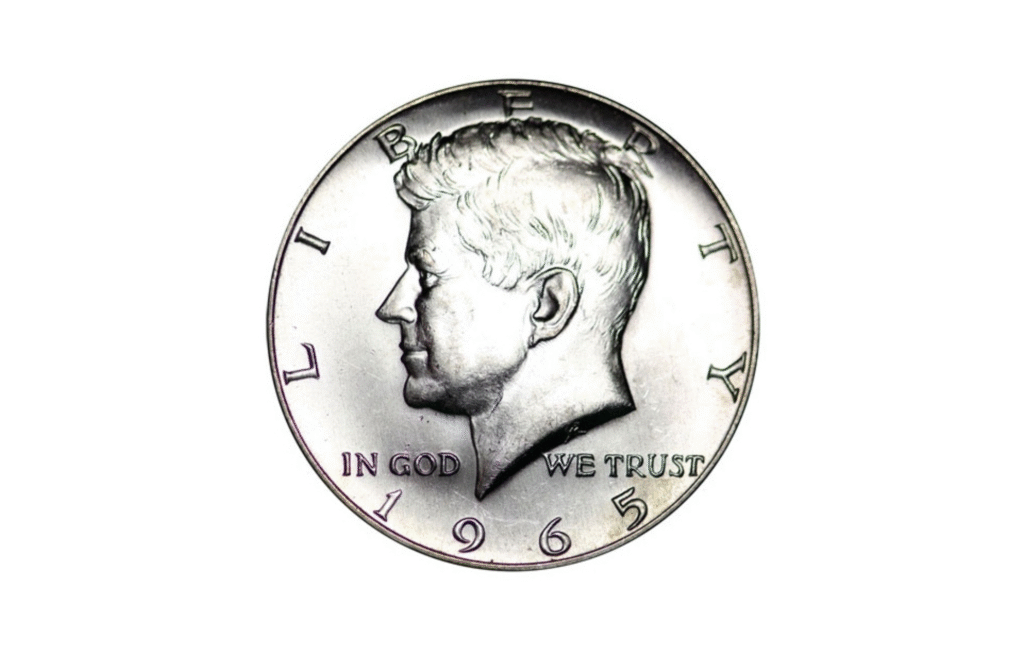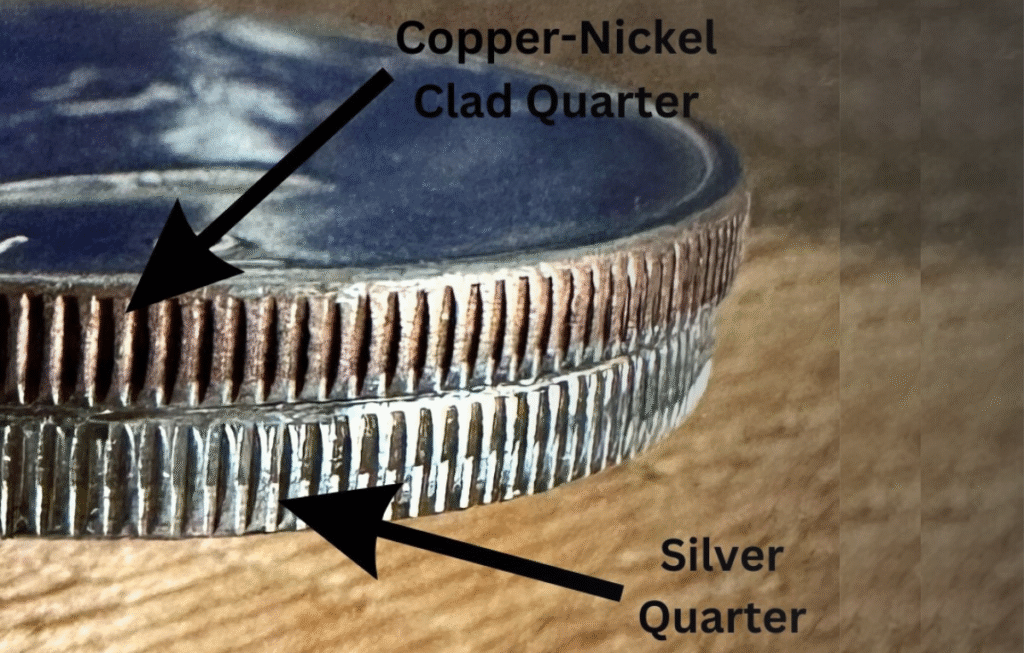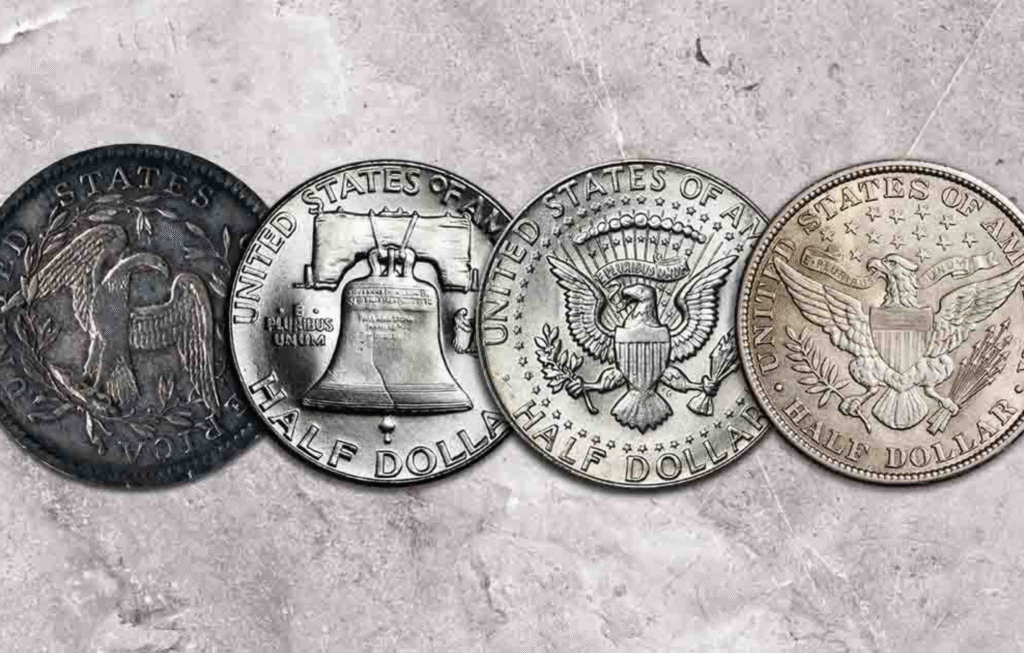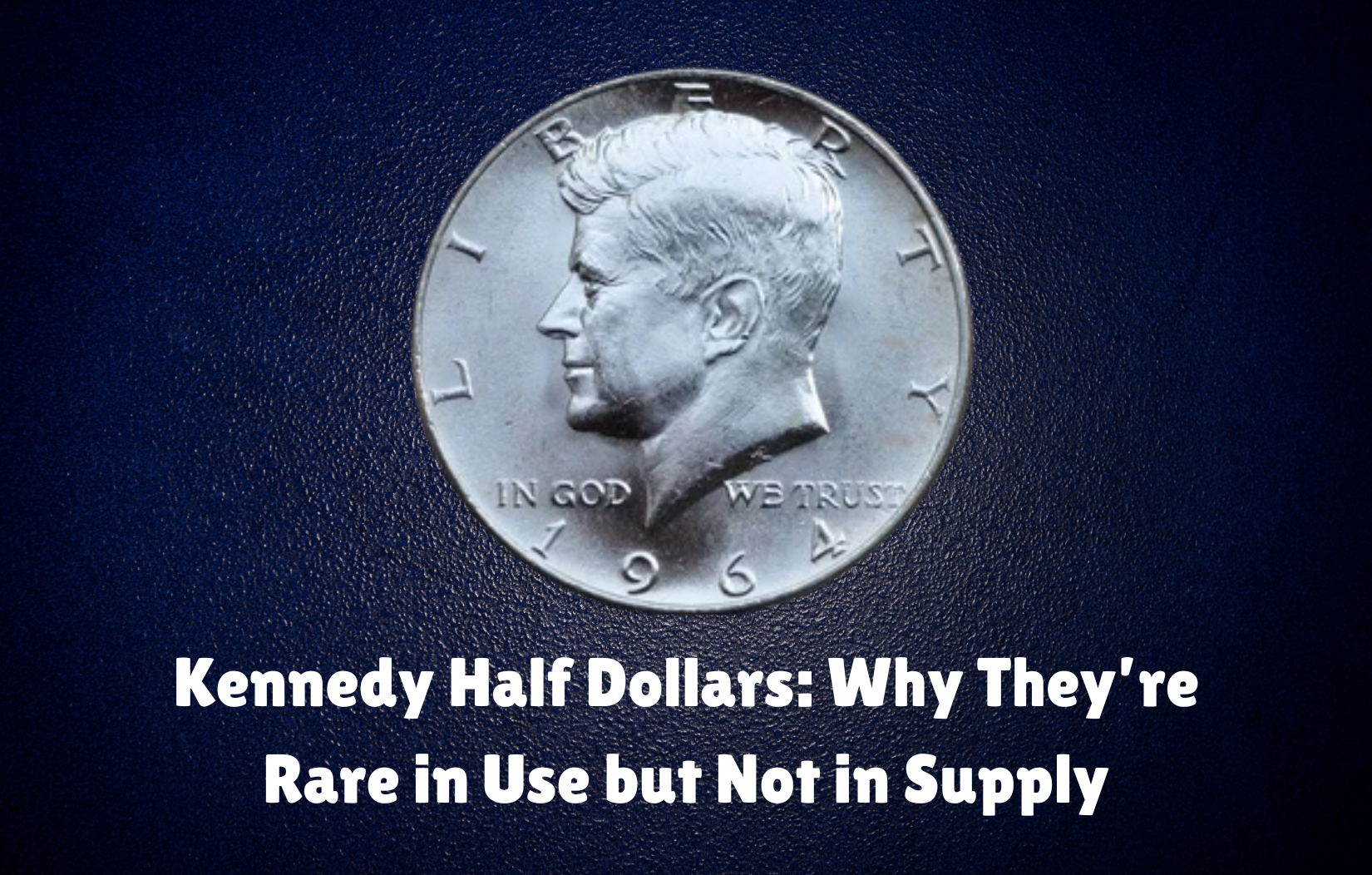Why Kennedy Half Dollars Rarely Circulate — But Still Exist in Banks
Introduction — The Curious Case of the Kennedy Half Dollar
If you live in the United States, you’re unlikely to see a Kennedy half dollar (50‑cent coin) show up in your change at a store. Yet despite their near absence in common transactions, these coins still exist, are minted, and can sometimes be found in banks, vaults, or coin rolls. How did a coin that once seemed destined for widespread use become so rare in circulation? And why does it still persist behind the scenes?
This article explores the full story — from their 1964 debut, through decades of decline, to the recent partial revival of circulation strikes — and explains the mechanisms that let the Kennedy half dollar survive, even if largely “hidden” from everyday commerce.
A Brief History: From Launch to Decline
1964: A New Symbol, in Silver
After the assassination of President John F. Kennedy in November 1963, Congress authorized a new design to honor him. The first Kennedy half dollars were struck in early 1964, composed of 90% silver — the same purity as other U.S. silver coinage of the era.
The public’s response was immediate and enthusiastic. Many people hoarded the new coins as keepsakes or speculative silver holdings, withdrawing them from circulation before they could become commonplace.
Silver Reductions (1965–1970) and Clad Transition

As silver prices rose, the U.S. government sought to reduce bullion costs. Starting in 1965, the Kennedy half dollar’s silver content was reduced to 40% (silver‑clad).
Still, even the reduced silver coins were often hoarded or melted if silver prices spiked.
By 1971, silver was removed entirely from circulating Kennedy halves. From then on, the coin was struck in a clad copper‑nickel composition, similar to quarters and dimes.
Falling Demand and Circulation Decline
Despite the technical adjustments, the Kennedy half never integrated strongly into everyday use. Several trends contributed:
- Public preference: For many everyday purchases, people used quarters (two quarters = 50¢) rather than carrying a larger 50‑cent coin. The half dollar felt bulky and inconvenient.
- Limited machine acceptance: Vending machines, parking meters, and coin-operated machines often did not accept half dollars, reducing utility.
- Bank and business demand decline: As retailers and banks ordered fewer half dollars, fewer entered circulation. The coin began to feel like a novelty.
By the 1980s, the coin was rarely seen. In fact, in 1987, no Kennedy halves were issued for general circulation — they were exclusively minted for collectors.
A Hiatus in Circulation Strikes (2002–2020)
Because circulating demand had shrunk to nearly nothing, the U.S. Mint stopped issuing Kennedy half dollars for general circulation after 2001. Starting in 2002, they were produced only for collectors, in rolls, bags, and mint/proof sets.
Still, the coin remained legal tender, and occasional pieces would surface via deposit returns or special channels.
Why They Rarely Appear in Everyday Commerce

Armed with history, let’s examine the obstacles that keep Kennedy halves from circulating widely now.
1. Weak Demand from Businesses and Consumers
Most people are accustomed to smaller denominations (pennies, nickels, dimes, quarters). A 50‑cent coin is less intuitive, bulkier, and less used in day‑to‑day transactions. Retailers often don’t stock it, and consumers rarely expect it as change.
Businesses, therefore, don’t order them, and banks in turn don’t stock them in bulk for retail disbursement.
2. Machine and Infrastructure Limitations
Many vending machines, coin acceptors, parking meters, and other coin‑handling equipment are not configured to accept half dollars. When machines reject them, businesses have even less incentive to carry them.
Cash registers and coin trays are often optimized for pennies, nickels, dimes, and quarters; some registers don’t even include a slot for halves.
3. Hoarding, Collectibility, and Novelty Appeal
From their debut, Kennedy halves attracted hoarding. Many people would keep them as souvenirs, especially silver or special mint issues. Even later, when silver content was removed, the half continued to be viewed as a special coin.
Because of that, when people did receive a half dollar, they often tucked it away rather than spend it — reducing circulation further.
4. Supply Chain and Distribution Choices
After 2001, since halves were no longer ordered systematically for circulation, they mostly existed in collector channels (rolls, bags, mint sets). Thus, many coins never entered the everyday banking or cash supply chains.
Even after circulation‑quality strikes resumed in 2021, many of those coins might still be held in vaults, banks, or in the numismatic secondary market rather than entering everyday commerce.
5. “Not Intended for Circulation” (NIFC) Issues
Between 2002 and 2020, nearly all Kennedy half dollars were produced as “collector issues” — not intended for general circulation. Occasionally, NIFC coins escape into circulation (via deposit or error), but the bulk remain in sealed sets or rolls.
Because they often bypass the normal cash distribution channels, NIFC coins are less likely to end up in the random change you receive at a store.
Recent Revival: Circulation Strikes Resume (2021–Present)
Despite decades of decline, the Kennedy half dollar hasn’t disappeared entirely. In recent years, the U.S. Mint and the Federal Reserve have taken steps to partially reintroduce them into circulation.
2021 and 2022: Federal Reserve Orders
In 2021, the Federal Reserve placed orders for Kennedy half dollars for distribution, prompting the Mint to strike 13.1 million coins for circulation.
In 2022, another 9.7 million coins were struck for circulation.
These were the first “circulating” Kennedy halves in nearly two decades.
2023 and Beyond: A Surge in Production
2023 saw a particularly large mintage — 58 million Kennedy half dollars were struck. Observers interpreted this as a sign that the Federal Reserve once again requested general circulation supply.
Significantly, more than a portion of those new coins were not sold as numismatic items but may have been incorporated into circulating channels.
The 2024 and 2025 mintings have also included “circulation quality” halves, though whether all of them are distributed broadly remains to be seen.
Still, many of those coins are being offered in bag or roll formats to collectors, which means that not all find their way into everyday commerce.
The Paradox: Where Are They Now?
Although tens of millions of new halves have been produced, they remain rarely seen in storefront change or in general circulation. Why?
- The coins may be held in bank vaults without being redistributed.
- Many may be ordered by coin dealers or collectors, not by general circulation channels.
- Some may circulate in niche settings, casinos, or among coin hobbyists rather than in everyday transactions.
In short, the reintroduction is real, but the pipeline into regular commerce is still weak and fragmented.
How Kennedy Half Dollars Still Exist in Banks

Given their scarce circulation, how does one ever find Kennedy half dollars in banks? Here are the mechanisms:
1. Bank Orders via Cash Services
Banks order coin inventory through cash services or armored carriers. If a bank or credit union requests half dollars (e.g., for businesses, coin change, or by customer demand), the providers may deliver them from mint or interbank stock. Even if halves aren’t highly requested, special orders or regional demand can bring them in.
Tellers sometimes keep a few rolls behind the counter for coin‑hunting customers or special requests.
2. Deposits and Mixed Coin Rolls
When customers deposit coins (e.g., cleaned collections, coin jars, casino play, or donation drives), those coins may include Kennedy halves among pennies, quarters, or dollars. The bank processes them and may re‑roll them for reissue. Some of those mixed rolls get redistributed.
In smaller banks or rural areas, these mixed rolls may sit for months before being returned to circulation, giving coin enthusiasts a chance to request them.
3. Numismatic / Collector Rolls Passing Through Banks
Some “collector rolls” or “bagged rolls” intended for coin buyers or dealers use banking channels as distribution. Occasionally, those rolls are brought into banks or “walk-in” branches, and customers or coin roll hunters can request them.
Even years marked as NIFC (not intended for circulation) sometimes slip out via bank turnover or deposit returns.
4. Regional / Niche Demand
Certain places — casinos, museums, specialty shops — may request or use half dollars (especially older or novelty versions). These places often source rolls from banks or mint suppliers, thus keeping some movement.
In short, while the average grocery store or fast-food counter may never see a half dollar, the banking and coin distribution network keeps a quiet supply alive via orders, deposits, and specialty channels.
What You Might Find in Bank Rolls
If you request half dollar rolls at a bank, you might come across:
- Modern clad halves (post‑1971) in uncirculated or lightly circulated grade
- Silver issues from 1964 (90% silver) or 1965–1970 (40% silver) — occasionally if someone deposited older coinage
- Proofs or special finishes that escaped mint sets
- NIFC issues (especially from the 2002–2020 era) that surfaced through deposit circuits
Collectors often roll‑hunt — asking tellers for “anything
unusual” or half‑dollar rolls — hoping to find silver or rare date coins.
Challenges and Uncertainties Going Forward
Even with a recent revival, the Kennedy half dollar faces several structural challenges that keep it from regaining mainstream circulation:
- Infrastructure inertia: vending machines, coin counters, retail registers may still not accept or stock halves
- Behavioral norms: consumers and retailers remain habituated to quarters, dollars, and smaller coins
- Distribution bottlenecks: even if produced, the coins may not be pushed through the everyday channels
- Collector demand: some half dollars are snapped up by collectors, decreasing the pool for circulation
- Future minting decisions: the Mint and Federal Reserve may scale back or stop circulation orders depending on demand
It is also worth noting that the Circulating Collectible Coin Redesign Act (2020) allows for redesign of circulating coins starting in 2026. That might stimulate interest or disrupt how half dollars are handled.
Conclusion
The story of the Kennedy half dollar is one of high hopes, evolving economics, and changing consumer behavior. Launched in silver in 1964 during a wave of public sentiment, the coin quickly became more a collectible than a practical medium of exchange. Over time, demand fell off, machines and registers ignored it, and the U.S. Mint ceased circulating strikes.
Yet, thanks to collector demand and occasional Federal Reserve orders, the Kennedy half dollar hasn’t vanished. It persists in banks, vaults, and coin rolls — quiet, almost invisible — but still legally spendable. For coin enthusiasts, it’s a fascinating hunt: requesting rolls at the bank might occasionally unearth a silver gem or surprising variety.
FAQs
1. Why don’t we see Kennedy half dollars in daily transactions?
They’re bulky, unfamiliar, and not widely accepted by machines or retailers, so most people don’t use them.
2. Are Kennedy half dollars still being made?
Yes, the U.S. Mint still produces them, especially for collectors and sometimes for limited circulation.
3. Can I get Kennedy half dollars at a bank?
Yes, some banks have rolls or can special order them if you request in advance.
